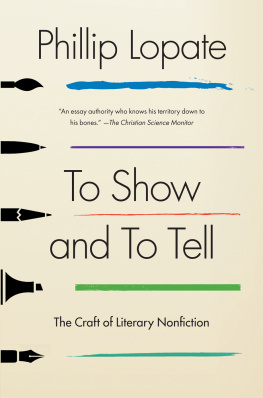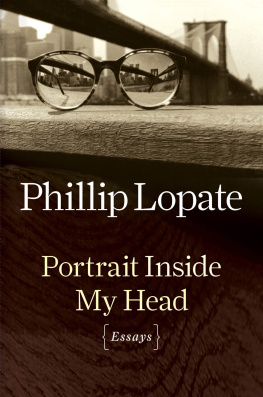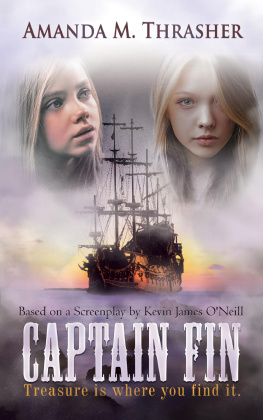Thank you for purchasing this Free Press eBook.
Join our mailing list and get updates on new releases, deals, bonus content and other great books from Free Press and Simon & Schuster.
C LICK H ERE T O S IGN U P
or visit us online to sign up at
eBookNews.SimonandSchuster.com
We hope you enjoyed reading this Free Press eBook.
Join our mailing list and get updates on new releases, deals, bonus content and other great books from Free Press and Simon & Schuster.
C LICK H ERE T O S IGN U P
or visit us online to sign up at
eBookNews.SimonandSchuster.com
ALSO BY PHILLIP LOPATE
Portrait Inside My Head
At the End of the Day
Notes on Sontag
Two Marriages
American Movie Critics: An Anthology From the Silents Until Now
Waterfront: A Journey around Manhattan
Rudy Burckhardt
Getting Personal: Selected Writings
Writing New York: A Literary Anthology
Totally, Tenderly, Tragically
Portrait of My Body
The Art of the Personal Essay: An Anthology from the Classical Era to the Present
Against Joie de Vivre
The Rug Merchant
Bachelorhood: Tales of the Metropolis
Confessions of Summer
The Daily Round
The Eyes Dont Always Want to Stay Open
Being with Children: A High-Spirited Personal Account of Teaching Writing, Theater, and Videotape


Free Press
A Division of Simon & Schuster, Inc.
1230 Avenue of the Americas
New York, NY 10020
www.SimonandSchuster.com
Copyright 2013 by Phillip Lopate
All rights reserved, including the right to reproduce this book or portions thereof in any form whatsoever. For information address Free Press Subsidiary Rights Department, 1230 Avenue of the Americas, New York, NY 10020.
First Free Press trade paperback edition February 2013
FREE PRESS and colophon are trademarks of Simon & Schuster, Inc.
The Simon & Schuster Speakers Bureau can bring authors to your live event. For more information or to book an event contact the Simon & Schuster Speakers Bureau at 1-866-248-3049 or visit our website at www.simonspeakers.com. Voice by Run Padgett, from Toujours lamour copyright 1976. Used by permission of the author.
Book design by Ellen R. Sasahara
Author photo Sally Gall
Cover design by Sook Kang
Cover art by Shutterstock
Library of Congress Cataloging-in-Publication Data
Lopate, Phillip.
To show and to tell : the craft of literary nonfiction /
by Phillip Lopate.1st Free Press trade paperback ed.
p. cm.
1. Creative nonfictionAuthorship. 2. AutobiographyAuthorship.
3. EssayAuthorship. 4. Prose literatureAuthorship. I. Title.
PN145.L67 2013
808.02dc23
2012025669
ISBN: 978-1-4516-9632-5
ISBN: 978-1-4516-9633-2 (ebook)
Contents

I.
The Craft of Personal Narrative
II.
Studies of Practitioners
Introduction

I should explain straight-out that I consider myself to be as much a teacher as a writer. Its not simply that a good deal of my annual income derives from teaching; its also that I find it a fascinating challenge, one that nourishes my psycheand my own writing. Many of my fellow writers treat teaching as a lower calling; they only do it to pay the rent, or until such time as they can support themselves entirely from royalties and advances. For my part, I think I would continue to teach even if I were to win the lottery. I find myself needing to articulate responses on the spot to any and all questions put me by students and their manuscripts, regardless of how much I may feel myself to be bluffing. I am also intrigued whenever I encounter resistance to my advice. Since I tend to doubt myself and my wisdom, I even feel some sympathy with those who want to question my prescriptions, though that does not stop me in the least from continuing to offer them.
Ever since my anthology The Art of the Personal Essay appeared, I have been looked to, rightly or wrongly, as a spokesperson for the essay, and for creative nonfiction or literary nonfiction (call it what you will) in general. I have been asked to speak at campuses and conferences across the country, and invariably I have been confronted with certain questionsformal, strategic, and ethicalthat seem to issue from an insistent anxiety or perplexity. Some of these questions have to do with the borderline between fiction and nonfiction or with the freedom to invent, appropriate, or embroiderwhat Ive come to regard as law and order issues. When this debate cropped up, my first impulse was to throw up my hands and say the whole controversy has been blown out of proportion and bores me, because it does not speak to where I live as a nonfiction writer (the urge to write the next sentence with as much style and thoughtfulness as I can muster). But I have come to see this neutral response on my part as hypocritical, because I do have opinions on such matters. So I have tried in these pages to explain them, though I hope it will be clear that I am talking about what works for me, not necessarily for everyone.
There are also vexing questions about the ethics of writing about others, particularly family members, intimates, and colleagues. There are questions of technique, such as how do you turn yourself into a character, how do you end an essay, and finally, how do you develop the capacity to think entertainingly and unconventionally on the page? The books title, To Show and to Tell , directly speaks to this last problem by challenging the clich of writing workshops, Show, dont tell. I am convinced that both are necessary in literary nonfiction.
What brought me to this conviction was reading older writers: the great personal essayists, memoirists, critics, biographers, and historians of the past. In a sense I am defending here the historical prerogatives of the literary nonfiction form, to charm and entice by way of a voice that can speak in more than one register, that can tell an anecdote, be self-mocking and serious by turns, and analyze a conundrum. My deepest inclination as a writer is historical: to link up what is written today with the rich literary lode of the past. My profoundest belief as a teacher is that many solutions for would-be literary nonfiction writers can be found in the library. To that end, I have included here a long list of exemplary books old and new. I have also included a series of literary case studiesCharles Lamb, William Hazlitt, Ralph Waldo Emerson, James Baldwin, and Edward Hoaglandto explore how nonfiction theory works in practice.
Some of these pieces were commissioned or requested; they may have gotten their start as conference talks, contributions to anthologies, even columns for Creative Nonfiction magazine. But they all speak to the same urgent question, of how to write intelligent, satisfying, engaging literary nonfiction.
So who is this book for? On the most basic level, it is for myself, to enable me to work through my thoughts on these questionsand for other nonfiction writers with similar concerns. It is certainly for other teachers of nonfiction and, I would hope, for graduate MFA nonfiction students. It is for what Virginia Woolf called the common reader, not a critic or scholar but someone who reads for his own pleasure rather than to impart knowledge or correct the opinions of others. It is meant as well for undergraduate teachers of composition and creative writingand their students. But it doesnt end there, because the roots of such pedagogical practice extend down to high school, middle school, and even elementary school, where teachers are increasingly being asked to inculcate in their charges the ability to write effective nonfiction.
Next page










